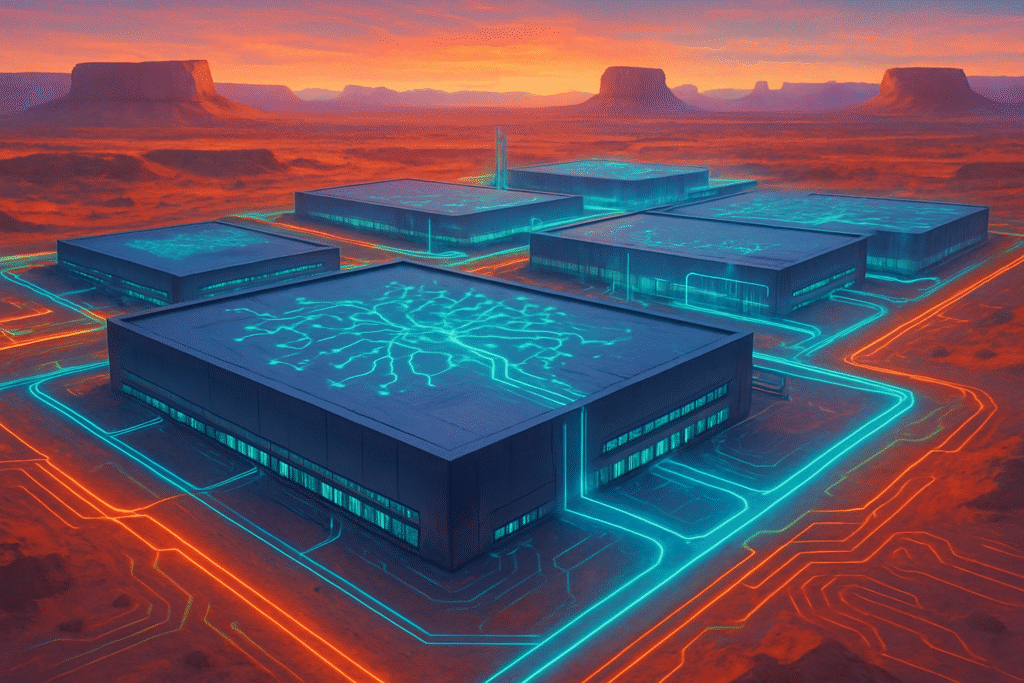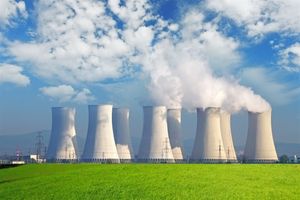
Taiwan Semiconductor Manufacturing Company (TSMC) (NYSE: TSM) is forging an unprecedented path in the American semiconductor landscape, committing a staggering $165 billion to establish a "gigafab cluster" in Arizona. This monumental investment, now the largest single foreign direct investment in a greenfield project in U.S. history, is rapidly transforming a vast tract of desert land into a global epicenter for advanced chip manufacturing. The ambitious undertaking is a direct strategic response to escalating geopolitical tensions and the insatiable demand for cutting-edge semiconductors, particularly those powering the artificial intelligence (AI) revolution and high-performance computing (HPC).
The Arizona gigafab cluster is envisioned as a comprehensive ecosystem, integrating multiple advanced wafer fabrication plants (fabs), state-of-the-art packaging facilities, and a major research and development (R&D) center. This strategic co-location, a proven model for TSMC in Taiwan, aims to cultivate a robust domestic supply chain, attracting a network of suppliers and partners to foster innovation and resilience. With its first fab already in high-volume production and subsequent fabs accelerating their timelines, TSMC's Arizona initiative is poised to significantly bolster U.S. national security, strengthen its technological leadership, and provide the indispensable silicon backbone for the next generation of AI innovation.
Arizona's Silicon Frontier: Unpacking the Gigafab's Technical Prowess
TSMC's Arizona complex, officially known as Fab 21, is not merely a collection of factories but a meticulously planned "gigafab cluster" designed to push the boundaries of semiconductor technology on American soil. With an investment projected to reach an astounding $165 billion, the site will eventually host six advanced wafer fabs, two state-of-the-art packaging facilities, and a dedicated R&D center, forming a comprehensive ecosystem for cutting-edge chip production.
The technical specifications highlight TSMC's commitment to bringing leading-edge nodes to the U.S. Fab 1 (Phase 1) commenced high-volume production in the fourth quarter of 2024, focusing on N4 (4nm) process technology, with a capacity reportedly around 15,000 wafers per month and plans to reach at least 20,000. Fab 2 (Phase 2), with its structure completed in 2025, is slated for N3 (3nm) production by 2028, a timeline TSMC is actively striving to accelerate due to surging AI demand. Looking further ahead, Fab 3 (Phase 3), which broke ground in April 2025, will introduce N2 (2nm) and the even more advanced A16 (1.6nm) process technologies, incorporating "Super Power Rail" for enhanced performance and efficiency, targeting volume production between 2028 and 2030. Fabs 4, 5, and 6 are also planned for N2, A16, and "even more advanced technologies," with their timelines driven by future market needs. Crucially, once fully operational, TSMC anticipates approximately 30% of its 2nm and more advanced capacity will be based in Arizona, significantly diversifying global supply.
This "gigafab cluster" approach marks a profound departure from previous U.S. semiconductor manufacturing efforts. Historically, domestic efforts often centered on older process nodes. In contrast, TSMC is directly importing its most advanced, leading-edge technologies—the very nodes indispensable for next-generation AI accelerators, high-performance computing, and specialized System-on-Chips (SoCs). Unlike fragmented past initiatives, this strategy aims to create an integrated, end-to-end ecosystem, encompassing not just fabrication but also advanced packaging and R&D, thereby fostering a more resilient and self-sufficient domestic supply chain. The sheer scale of the $165 billion investment further underscores its unprecedented nature, dwarfing prior foreign direct investments in greenfield semiconductor manufacturing in the U.S.
Initial reactions from the AI research community and industry experts are largely optimistic, tempered with pragmatic concerns. There is widespread acknowledgment of TSMC's indispensable role in fueling the AI revolution, with experts calling its advanced manufacturing and packaging innovations "critical" and "essential" for sustaining rapid AI development. Figures like NVIDIA (NASDAQ: NVDA) CEO Jensen Huang have publicly affirmed the foundational importance of TSMC's capabilities. The project is lauded as a strategic advantage for the U.S., enhancing technological leadership and securing domestic access to advanced chips. However, concerns persist regarding the substantially higher manufacturing costs in the U.S. (estimated 35-50% more than in Taiwan), potential workforce culture clashes, construction delays due to complex regulations, and the immense energy demands of such facilities. Despite these challenges, the prevailing sentiment is that TSMC's Arizona cluster is a transformative investment for U.S. technological sovereignty and its strategic position in the global AI landscape.
Reshaping the AI Hardware Landscape: Winners, Losers, and Strategic Shifts
TSMC's Arizona gigafab cluster is poised to profoundly reshape the competitive dynamics for AI companies, tech giants, and even nascent startups, fundamentally altering how advanced AI silicon is conceived, produced, and deployed. This multi-billion-dollar investment, strategically driven by the escalating demand for AI chips and geopolitical imperatives, aims to fortify the U.S. semiconductor supply chain and cultivate a localized ecosystem for leading-edge manufacturing.
The primary beneficiaries of this domestic advanced manufacturing capability will be major American AI and technology innovation companies that are key TSMC customers. NVIDIA (NASDAQ: NVDA), a titan in AI acceleration, plans to produce its advanced Blackwell AI chips at the Arizona facility, aiming to build substantial AI infrastructure within the U.S. Similarly, Advanced Micro Devices (AMD) (NASDAQ: AMD) has initiated production of its fifth-generation EPYC processors and is leveraging TSMC's advanced N2 process for future generations in Arizona. Apple (NASDAQ: AAPL) has committed to being the largest customer, utilizing 3nm for its M4 and M5 chips and eyeing 2nm capacity for future A20 and M6 chips. Other significant customers like Broadcom (NASDAQ: AVGO) and Qualcomm (NASDAQ: QCOM) will also benefit from localized production. Furthermore, hyperscalers such as Alphabet (NASDAQ: GOOGL), Amazon (NASDAQ: AMZN), and Microsoft (NASDAQ: MSFT), who increasingly design their custom AI ASICs, will find the Arizona fabs crucial for their burgeoning AI infrastructure development, securing a critical domestic source for their proprietary silicon.
The competitive implications for major AI labs and tech companies are substantial. The domestic availability of cutting-edge hardware is foundational for building and deploying increasingly sophisticated AI models, thereby strengthening the U.S. position in AI innovation. For companies like NVIDIA, AMD, and Apple, a localized supply chain significantly mitigates geopolitical risks, reduces logistics complexities, and promises greater stability in product development and delivery—a strategic advantage in a volatile global market. While Intel (NASDAQ: INTC) is aggressively pursuing its own foundry ambitions, TSMC's recognized superiority in advanced-node manufacturing still presents a formidable challenge. However, Intel Foundry's advanced packaging capabilities in the U.S. could offer a unique competitive edge, as TSMC's most advanced packaging solutions, like CoWoS, largely remain in Taiwan. The indispensable role of TSMC also risks centralizing the AI hardware ecosystem around a few dominant players, potentially creating high barriers to entry for smaller firms lacking significant capital or strategic alliances.
However, this transition is not without potential disruptions. Chips produced in Arizona are projected to be significantly more expensive—estimates range from 5% to 50% higher than those from Taiwan—primarily due to elevated labor costs, stringent regulations, and the complexities of establishing a new supply chain. These increased costs could eventually translate to higher consumer prices for AI-powered devices and services. Operational challenges have also emerged, including workforce cultural differences, with TSMC's demanding work ethic reportedly clashing with American labor norms, leading to staffing difficulties and construction delays. TSMC has also cautioned against potential U.S. tariffs on foreign-made chips, warning that such measures could undermine its substantial Arizona investment by increasing costs and dampening demand. Despite these hurdles, the strategic advantages of onshoring critical manufacturing, accelerating the AI revolution with a localized chip supply chain, and establishing a strategic hub for innovation are undeniable, positioning Phoenix as a burgeoning tech epicenter.
A New Era of Silicon Diplomacy: Geopolitics, Resilience, and Sovereignty
TSMC's Arizona gigafab cluster transcends mere economic investment; it represents a profound strategic realignment with far-reaching implications for the global AI landscape, geopolitical stability, supply chain resilience, and technological sovereignty. This monumental $165 billion commitment, encompassing up to six fabs, two advanced packaging facilities, and an R&D center, is a testament to the critical role semiconductors play in national power and the future of AI.
Within the AI landscape, the Arizona fabs are poised to become a vital artery, pumping cutting-edge silicon directly into the heart of American innovation. Producing chips based on 4nm, 3nm, 2nm, and eventually A16 (1.6nm-class) process technologies, these facilities will be indispensable for powering next-generation AI accelerators, high-performance computing platforms, advanced mobile devices, autonomous vehicles, and emerging 6G communications infrastructure. This localized production ensures that leading American tech giants and AI companies, from Apple to NVIDIA, AMD, Broadcom, and Qualcomm, have a more secure and diversified supply chain for their most critical components. The integration of advanced packaging and a dedicated R&D center further solidifies a domestic AI supply chain, fostering innovation, particularly for burgeoning AI hardware startups. TSMC's own projections of doubling AI-related chip revenue in 2025 and sustained mid-40% annual growth for the next five years underscore the Arizona cluster's pivotal role in this AI supercycle.
Geopolitically, the Arizona investment is a cornerstone of the U.S. strategy to enhance technological independence and mitigate reliance on overseas chip production, especially from Taiwan. Supported by the CHIPS and Science Act, it's a direct move to re-shore critical manufacturing and counter China's escalating technological ambitions. For Taiwan, diversifying TSMC's manufacturing footprint to the U.S. offers a degree of risk mitigation against potential regional conflicts and strengthens strategic ties with Washington. However, some voices in Taiwan express concern that this could potentially "hollow out" their domestic semiconductor industry, thereby eroding the island's "silicon shield"—the critical global reliance on Taiwan's advanced chip manufacturing as a deterrent to aggression. The move risks intensifying the global tech rivalry as it may accelerate China's drive toward semiconductor self-sufficiency.
In terms of supply chain resilience, the lessons from the COVID-19 pandemic and ongoing geopolitical tensions have underscored the vulnerabilities of a highly concentrated global semiconductor ecosystem. TSMC's Arizona cluster directly addresses these concerns by establishing a crucial manufacturing base closer to U.S. customers. By diversifying production locations, the initiative enhances the resilience of the global supply chain against potential disruptions, whether from natural disasters, trade wars, or cyberattacks. While "far-shoring" for TSMC, it acts as a crucial "nearshoring" for U.S. companies, reducing logistical complexities and geopolitical risks in their product development cycles. This commitment is a monumental step towards reclaiming technological sovereignty for the United States, which once dominated semiconductor manufacturing but saw its share dwindle. The CHIPS Act, with the Arizona fabs at its core, aims to reverse this trend, ensuring a domestic supply of cutting-edge chips vital for national security, economic stability, and maintaining a competitive edge in critical technologies.
Despite its strategic advantages, the project faces significant concerns. Manufacturing costs in the U.S. are considerably higher (30% to 50% more than in Taiwan), potentially leading to increased chip prices and impacting global competitiveness. Labor issues, including a shortage of skilled workers, cultural clashes between Taiwanese and American workforces, and allegations of a hostile environment, have contributed to delays. The immense demands for water (4.7 million gallons daily for the first fab) and power (2.85 gigawatt-hours per day) in an arid region like Arizona also pose substantial environmental and infrastructure challenges. This development is comparable to historical moments of strategic technology mobilization, echoing past national endeavors to secure critical technologies. It marks a historic milestone as the most advanced chip fabrication site in the U.S., a strategic shift in an era where globalization and free trade are increasingly challenged, emphasizing national security over purely economic drivers.
The Road Ahead: Arizona's Ascent as an AI Silicon Powerhouse
The trajectory of TSMC's Arizona gigafab cluster points towards a future where the U.S. plays an increasingly prominent role in advanced semiconductor manufacturing, particularly for the burgeoning field of artificial intelligence. With an investment now soaring to $165 billion, TSMC's long-term commitment to the region is undeniable, envisioning a comprehensive ecosystem of up to six fabs, two advanced packaging facilities, and a dedicated R&D center.
In the near term, Fab 1 has already commenced high-volume production of N4 (4nm) chips in Q4 2024, delivering silicon for major clients like Apple (NASDAQ: AAPL) and AMD (NASDAQ: AMD) with impressive yields. Looking to the mid-term, Fab 2, with its structure completed in 2025, is targeting N3 (3nm) volume production by 2028, a schedule TSMC is actively accelerating to meet relentless customer demand. The long-term vision includes Fab 3, which broke ground in April 2025, slated for N2 (2nm) and A16 (1.6nm) process technologies, with production anticipated by the end of the decade. Beyond these, Fabs 4, 5, and 6 are planned to adopt even more advanced technologies, with TSMC actively seeking additional land for this expansion. Crucially, the R&D center and two advanced packaging facilities, including a collaboration with Amkor Technology Inc. (NASDAQ: AMKR) for CoWoS and InFO assembly starting in early 2028, will complete the localized AI supply chain, though some advanced packaging may initially still occur in Taiwan.
The chips produced in Arizona are set to become the backbone for a myriad of advanced AI applications. The 5nm and 3nm nodes are critical for state-of-the-art AI accelerators, powering the next generation of generative AI, machine learning, and high-performance computing workloads from industry leaders like NVIDIA (NASDAQ: NVDA) and AMD. Notably, TSMC's Arizona facility is slated to produce NVIDIA's Blackwell AI chips, promising a revolution in chatbot responses and accelerated computing with significantly faster processing. Beyond core AI, these advanced chips will also drive next-generation mobile applications that increasingly embed AI functionalities, as well as autonomous vehicles and 6G communications. TSMC's goal for approximately 30% of its 2nm and more advanced capacity to be in Arizona underscores its commitment to creating an independent, leading-edge semiconductor manufacturing cluster to meet this explosive demand.
However, the path forward is not without significant challenges. A persistent skilled labor shortage remains a key hurdle, leading to delays and necessitating the deployment of Taiwanese experts for training. High manufacturing costs in Arizona, estimated to be 50% to even double those in Taiwan due to higher labor, a less developed local supply chain, and increased logistics, will need careful management to maintain competitiveness. The immense water and power demands of the gigafab in an arid region present environmental and resource management complexities, though TSMC's commitment to advanced water recycling and "near-zero liquid discharge" is a proactive step. Supply chain gaps, regulatory hurdles, and cultural differences in the workplace also require ongoing attention. Experts predict TSMC will remain the "indispensable architect of the AI supercycle," with accelerated expansion and advanced node production in Arizona solidifying a significant U.S. hub. This presence is also expected to catalyze broader industry integration, potentially attracting other high-tech manufacturing, as evidenced by proposals like Softbank's Masayoshi Son's suggested $1 trillion industrial complex for robots and AI technologies in Arizona, naming TSMC as a key partner. Despite rapid buildouts, capacity for advanced chips is expected to remain tight through 2026, highlighting the urgency and critical nature of this expansion.
The Dawn of a New Silicon Age: Arizona's Pivotal Role in AI's Future
TSMC's audacious "gigafab cluster" in Arizona stands as a testament to a new era in global technology—one driven by the relentless demands of artificial intelligence and the strategic imperative of supply chain resilience. This monumental $165 billion investment, now the largest foreign direct investment in U.S. history, is not merely building factories; it is constructing a future where the United States reclaims its leadership in advanced semiconductor manufacturing, directly fueling the AI supercycle.
Key takeaways from this unparalleled undertaking are multifold. TSMC is establishing a comprehensive ecosystem of up to six advanced wafer fabs, two cutting-edge packaging facilities, and a major R&D center, all designed to produce the world's most sophisticated logic chips, from 4nm to 1.6nm (A16). The first fab is already in high-volume production, delivering 4nm chips with yields comparable to Taiwan, while subsequent fabs are on an accelerated timeline, targeting 3nm and 2nm/A16 production by the end of the decade. This massive project is a significant economic engine, projected to create approximately 6,000 direct high-tech jobs and tens of thousands more in construction and supporting industries, driving hundreds of billions in economic output. While challenges persist—including higher operating costs, skilled labor shortages, and complex regulatory environments—TSMC is actively addressing these through strategic partnerships and operational adjustments.
The significance of TSMC Arizona in AI history and the broader tech landscape cannot be overstated. It is the indispensable architect of the AI revolution, providing the advanced silicon that powers generative AI, machine learning, and high-performance computing for industry giants like NVIDIA, Apple, and AMD. By establishing a localized AI chip supply chain in the U.S., the cluster directly strengthens America's semiconductor resilience and leadership, reducing dependence on a geographically concentrated global supply. This initiative is a cornerstone of the U.S. strategy to re-shore critical manufacturing and foster a robust domestic ecosystem, attracting a constellation of research institutions, talent, and ancillary industries.
In the long term, TSMC Arizona is poised to solidify the state's position as a global semiconductor powerhouse, profoundly transforming its economy and workforce for decades to come. For the U.S., it marks a critical step in reasserting its dominance in chip production and mitigating geopolitical risks. However, the higher costs of U.S. manufacturing will necessitate ongoing government support and may influence future pricing of advanced nodes. The delicate balance between diversifying production and maintaining Taiwan's "silicon shield" will remain a strategic consideration, as will the continuous effort to bridge cultural differences and cultivate a highly skilled local workforce.
In the coming weeks and months, industry observers should closely monitor the production ramp-up and yield rates of the first fab, particularly as it reaches full operational status. Watch for continued construction progress and key milestones for the 3nm and 2nm/A16 fabs, as well as developments in addressing labor and supply chain challenges. Any further disbursements of CHIPS Act funding or new U.S. government policies impacting the semiconductor industry will be critical. Finally, keep an eye on the broader economic impact on Arizona and the progress of advanced packaging facilities and the R&D center, which are vital for completing the domestic AI supply chain. This is not just a story of chips; it's a narrative of national strategy, technological destiny, and the relentless pursuit of AI innovation.
This content is intended for informational purposes only and and represents analysis of current AI developments.
TokenRing AI delivers enterprise-grade solutions for multi-agent AI workflow orchestration, AI-powered development tools, and seamless remote collaboration platforms.
For more information, visit https://www.tokenring.ai/.





